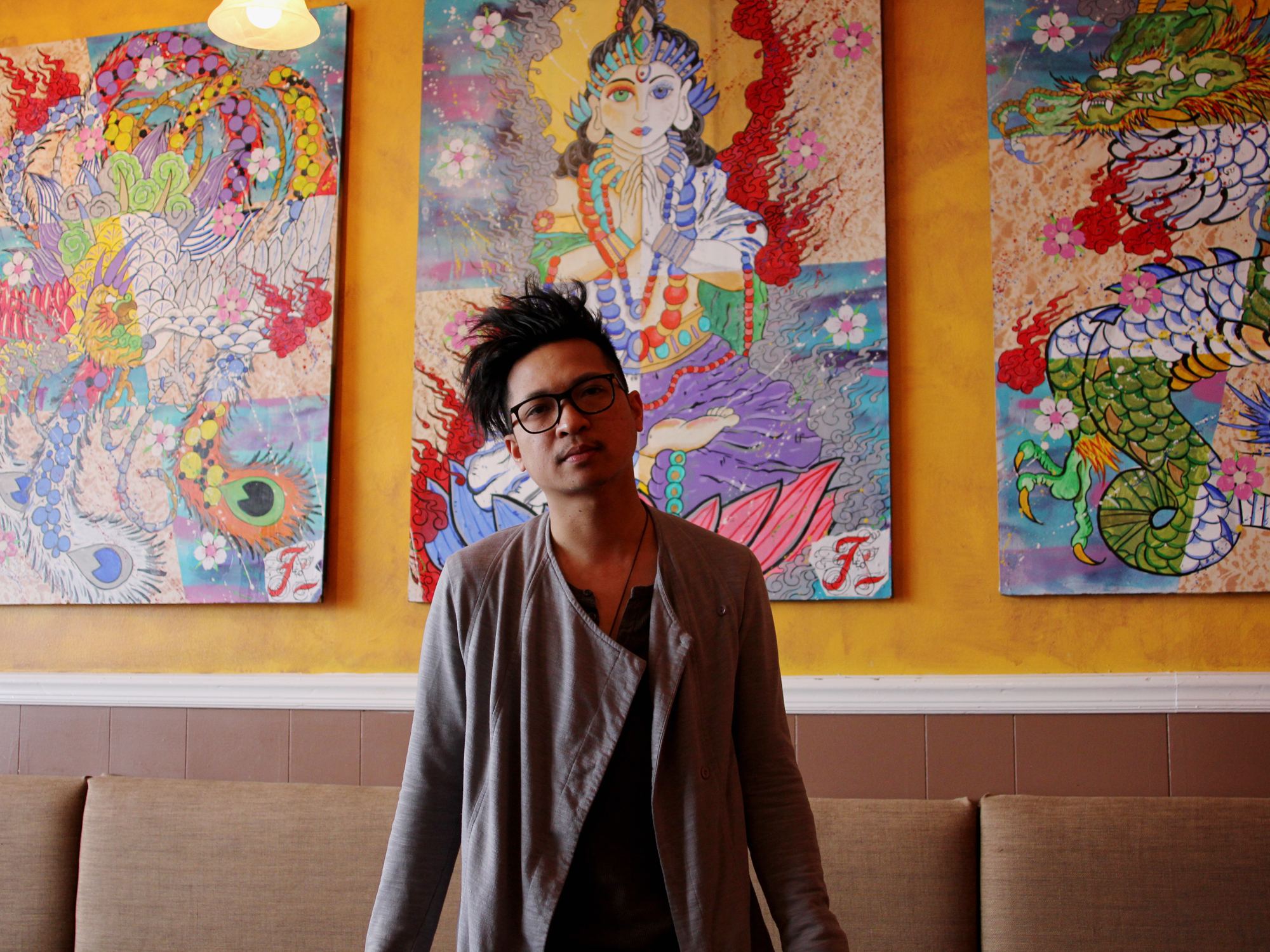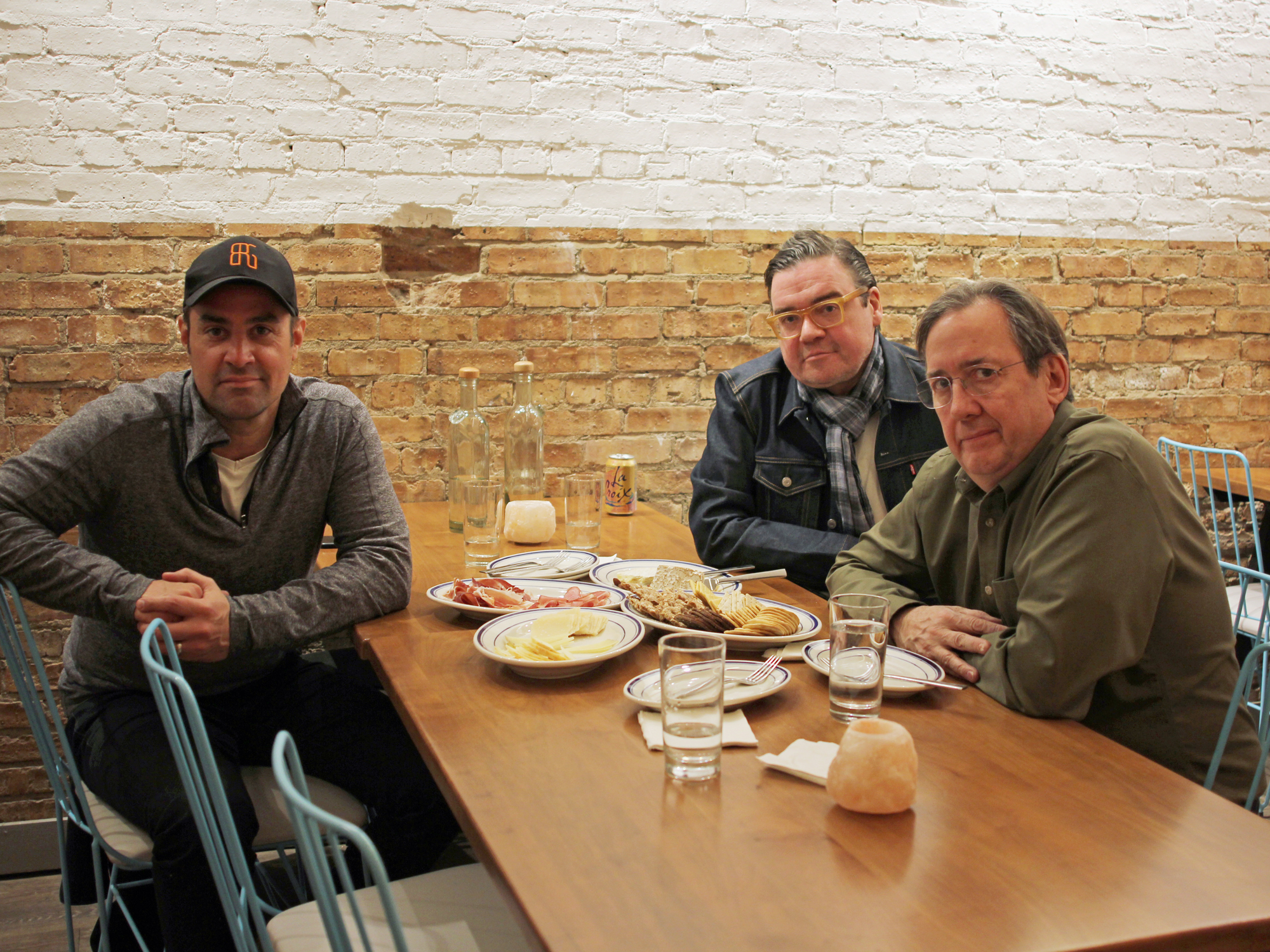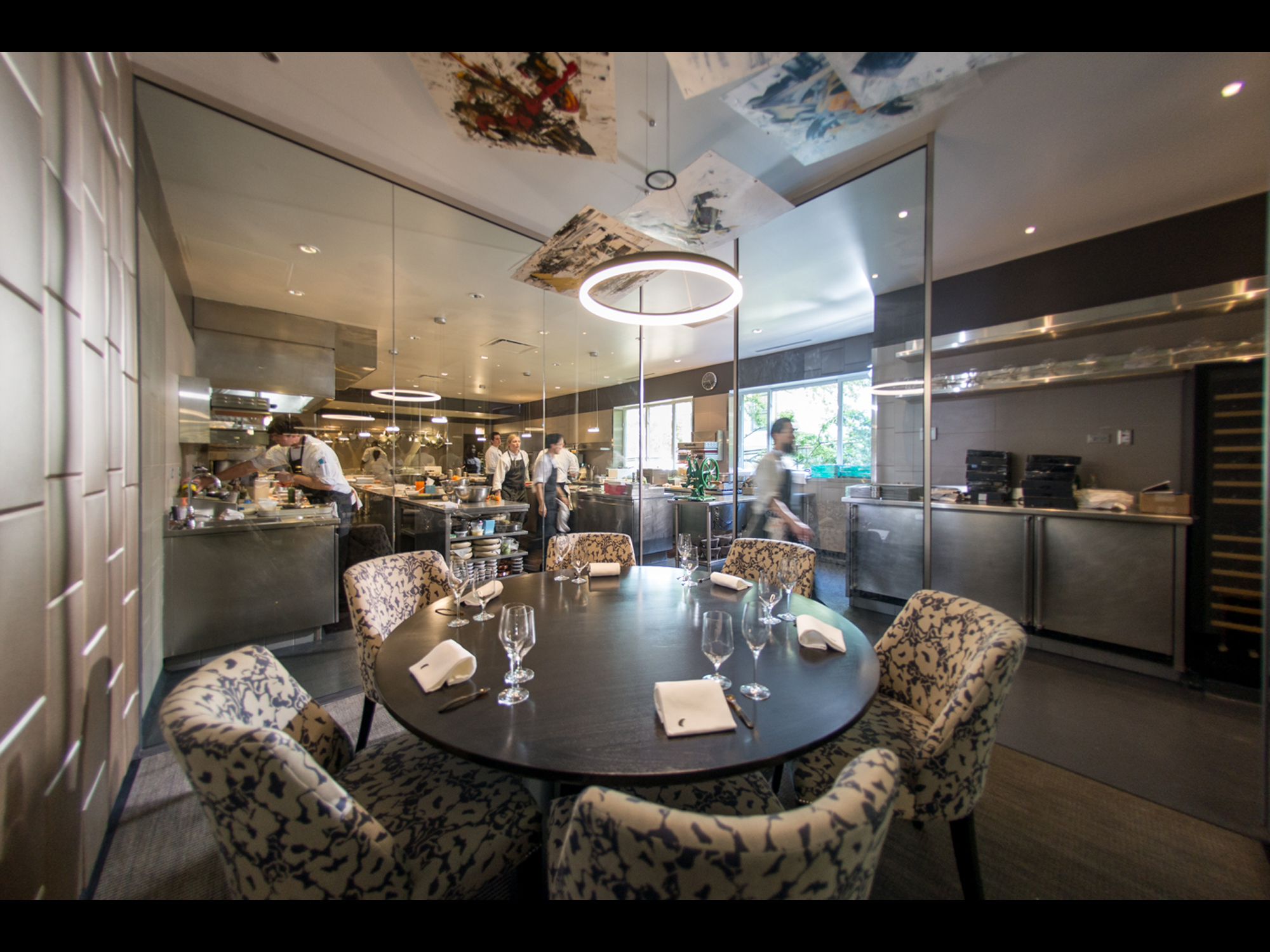I HAVE A CONFESSION TO MAKE AS a food writer. Until last weekend, I’d never been to the most-celebrated restaurant in Chicago, the last remaining three Michelin star spot in the city, the fourth-highest-ranked American restaurant on the World’s 50 Best list: Alinea.
* * *
I know so much about Alinea that I’m hyperconscious of my own expectations the moment I walk in. They’re reputed to keep lots of data on their customers—where they sat, right handed or left handed, doesn’t like green beans—but how does a never-before-customer who’s been here as a journalist show up in their system? “This is your first time, correct?” she asks me, and I detect a hint of “Can that be right if he’s a food writer?” (Followed by the voice in my head saying, “Don’t flatter yourself.”)
At the end of the meal, as we’re being led downstairs, I ask the man who was, perhaps, our lead server if it had been repainted since the renovation (I recall an aqua blue color to some of the walls that was noticeably louder than the neutral grays we’ve been dining with all night). He seems puzzled—he clearly knows that we were first timers, and asks where I saw it. (In pictures. Not hard to find.) Turns out different rooms have different colors, and one of them is aqua.
So they’d looked me up enough to know that I hadn’t dined here before, but not enough to know that I’d already been inside Alinea a few different times.
* * *

I haven’t dined at Alinea? Really? Well, neither have lots of other people, even lots of other people in Chicago journalism. In fact, the Tribune’s Michael Phillips just confessed in print that he had never “eaten at any of Chicago’s most rarified and distinguished emporiums for molecular gastronomy,” a group which obviously includes Alinea, in the process of reviewing a movie about another high end restaurant.
But he’s a movie reviewer; we don’t expect him to have been in World War II to review Dunkirk. It’s different for someone who passes himself off as a know-it-all about food—which isn’t quite true (no one knows it all) but is true enough that I can give you a pretty good answer to almost any “where to go for…” question. A food writer having been everywhere in town but Grant Achatz’s three-Michelin-star temple is like a theater reviewer having seen Hamilton, but never Hamlet. Right?
* * *
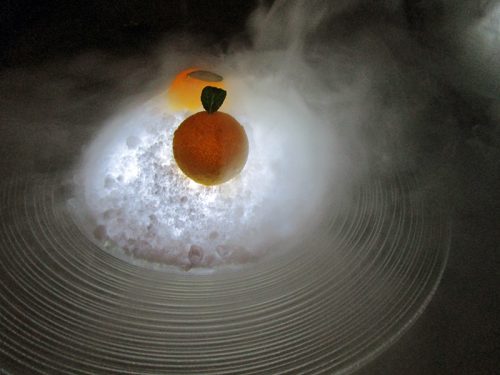
When we first sit down, there’s a whole bowl of oranges, surrounded by their leaves and one sliced in half, sitting on our table, and the scent of oranges wafting in the air. This should not seem as big a deal as it does—I could go buy a whole bag of oranges for $6.99 at Mariano’s. But in the wintry-gray room where we’ll spend the evening, this largesse feels like a display of wealth—a bounty of sunny citrus in an icy clime. The first few courses will all present plays on this theme, often mixed with notes of seafood.
Maybe it’s because I grew up as far from the sea as you can get, but if anything feels like the mark of a fine restaurant to me, it’s a dish that fully showcases the subtlety of seafood—evanescent notes of sea water and brine, gently mixed into other flavors. I’m sure part of the reason the first few courses stuck with me the most the next day is because they were the first few courses, when my palate was freshest.
But crab in a coconut curry, a romaine spear topped with avocado and tosaka seaweed, a little bowl of bouillabaisse with a gelatin noodle full of flavor from langoustines—these dishes show a masterful hand in the kitchen at treating seafood flavors with enough delicacy to prevent them being overwhelmed, yet taking them in the direction of another flavor—like Asian pear brandy snow. (There’s a lot of snow in these early dishes.) The Japanese influence immediately reminds me of Tempura Matsu in Kyoto—whose chef staged at Alinea 8 or 9 years ago. Not just because of a similar treatment of delicate sea flavors, but because each dish was a tiny mystery, inviting you in.
* * *

Anyone writing about food in Chicago should have gone to Alinea. That is as obvious as that anyone writing about sports should have seen the Bulls play, anyone writing about art should have seen the collection of Impressionists at the Art Institute.
Obvious, but I wonder how true it is. We know that reviewers have—Phil Vettel and Jeff Ruby have both been since the 2016 renovation, Michael Nagrant contributed to the Alinea cookbook (strategically placed around the restaurant, including as something to leaf through while you wait for the bathroom).
But beyond that, it’s clear that the economics of writing about extremely expensive restaurants on what freelancers get paid make no sense, and so I suspect most of the rest of us in the Chicago food media community walk around with the secret that was mine until last weekend. Other restaurants treat writers (and Instagrammers and influencers and anything else that seems like it might draw an audience) to media dinners, like it or not a necessity in a $50-an-assignment world.
But Alinea Group does not. They don’t invite Chicago writers in for free dinners because really, they’re not aiming at the Chicago food audience—their audience is the world, national magazines and international food honors and global jet setters who fly in to do dinner at Alinea Friday, Acadia Saturday and Sixteen Sunday. It’s not their fault, but it’s an undeniable fact that there’s an Alinea-sized hole in the knowledge base of much of Chicago food journalism in the late 2010s, even as it stands for so much of Chicago dining to the world.
(I should point out that they have invited me to a few parties over the years—which is why I had at least had Achatz’s original signature dish, Black Truffle Explosion.)
* * *
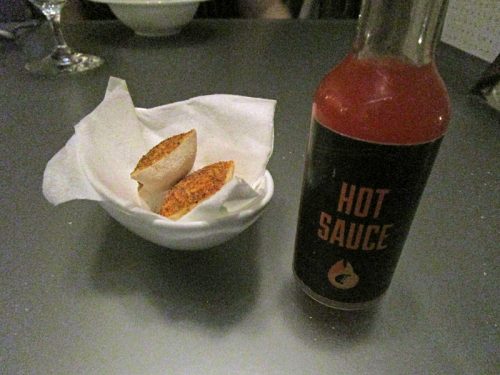
Tasting menus have to follow a few rules, no matter how innovative they are, because the human palate can only work certain ways. You start with light, delicate dishes—a lot of vegetables and seafood—and progress to more robust things. And nothing is ever too strong, too garlicky, too spicy—because those would blow out your palate for the dishes to follow.
Which is why, when a bottle of housemade hot sauce (labeled to masquerade as a commercial product) appears, we’re immediately told that it’s not too hot—it gives off a discernible whiff of vinegar and red pepper, but doesn’t really impart any fire. This is maybe the main characteristic of dining at Alinea: Things Are Not What They Seem. The snow that accompanies the first dishes is genuine snow, until it isn’t any more and it gets set on fire. Rocks are rocks, except when they’re not. Alinea is a restaurant, except that it’s really a show that contains a restaurant.
This sleight of hand—dishes billed as “a play on” this or that—was big a decade or so ago at Alinea, and at Moto (the cigar that was really a sandwich) and Graham Elliot (the deconstructed Caesar salad that was mostly a giant crouton). Others still do it—Schwa, whose owner Michael Carlson worked under Achatz at Trio, does it from time to time—but it seems safe to say that nobody in America is still working it as hard as Alinea, drawing travelers in for dishes that promise to be one thing and turn out to be another.
If Alinea was a spur from Trotter and El Bulli, it seems like many of the chefs who started down that path with Achatz eventually walked it back a little.
It’s a mind bending delight when it works. But as we move through the savory courses, it doesn’t always work. The hot sauce and the oyster cracker go with a clam chowder that comes from an ISI canister, like whipped cream. (There’s more to it than that which I won’t spoil.) But the chowder, surprisingly given the earlier seafood courses, has no clam flavor and a gluey texture, and it isn’t helped by hot sauce that isn’t hot.
A few things are billed as being like Black Truffle Explosion, in that you’re supposed to pop them in whole and see what they prove to be as they explode in your mouth. But one is advertised as containing olive and artichoke—a lot of olive and artichoke cream, too much of those bitter flavors to be pleasant when your mouth is filled with them. Other times plates come with too many elements that have been deconstructed down into gelatinized goo of some sort, losing any sort of integrity of the individual ingredients. (A lot of this meal gets stuck in my teeth.)
By some mid-meal point I’m longing for a thing that is just itself, treated beautifully, again. The tricks have to be delicious as well as culinarily ingenious, and enough times they aren’t, breaking the magic spell of the start of the meal.
* * *

Why haven’t I been here before?
Well, I have been here—to shoot video, a few times. And I’ve eaten at Trio, where Achatz first made his name here, and recorded a 23-course meal in loving detail. I’ve eaten at Next multiple times, and Roister, and The Aviary and The Office. I’ve eaten the food of people who came from Alinea—Curtis Duffy’s at Grace, and John Shields’ at Smyth, and Jeff Pikus and Andrew Brochu and Dana Cree and David Posey and so on and on, not to mention Schwa, the other side of the fork in the road from Trio to Alinea. I’ve eaten around Alinea for years.
I really should have gone a long time ago. But you know, it’s expensive, and there’s a number of expensive places and only so many times I could drop that big a wad, and by the time I became an actual, semi-professional food writer Alinea had already been around for a few years and there was always something new I needed to know for myself. So I spent that wad at Avenues, and Grace, and Elizabeth and EL Ideas and 42 Grams and Oriole and Smyth and so on, all of which seemed more urgent at the time. It’s a defensible choice.
But honestly, there’s something else. Alinea intimidated me. If it was that good… well, one, what if it wasn’t, the world would get a little smaller and less exciting. And if it was, then I’d have crossed off one of the potential ultimate dining experiences in my life, and the remaining possibilities offered by the world would get a little smaller. This is, in fact, a stupid way to look at life, but I wasn’t doing it consciously so much as letting a little voice saying it nudge me toward doing something else first.
And then, eventually, it can become having waited too long to go to a restaurant. I went to The French Laundry a couple of years ago and many parts of it were great, but there was kind of a greatest hits feel to the meal, dishes I knew from the cookbook or from other people imitating them, that wasn’t the same as going there when it was dazzlingly new and different. Alinea’s big 2016 renovation couldn’t entirely reset the clock and make Things Are Not What They Seem a new concept, but it was as close as anything could ever get to that. Time to go at last.
* * *
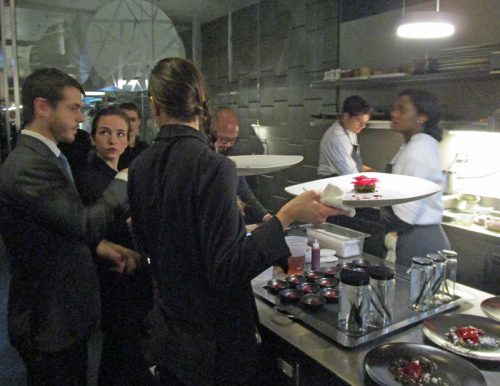
In fact, it’s surprising how meta the jokes and gags and magic tricks can get at Alinea.
Early on, when a box of rocks arrived at the table (just stick with me here), I said, half-jokingly, that I hoped we weren’t going to cook on them—I’d been to Next a few times and I knew all about cooking on hot rocks. The server kind of heh-heh’d nervously—casual banter about the restaurant does not come easily to them, but to be fair, when they asked me how I liked this or that, I pretty much stammered like a moron (“Fine. Great. Really nice”) in return. In any case, I was assured that nothing would be cooked at the table on a rock.
Then one of the savory courses arrived, and it was a piece of squab… and the rock was on it. Actually it was binchotan, a piece of Japanese charcoal, but same difference.
Similarly, at one point we found ourselves with a bowl of freshly cut lavender. (Again, trust me on this, it made sense at the time.) And the server tells us that he’s going to pour water from a tea kettle on it to spread the aroma. And from the tea kettle comes… water with dry ice in it. We thought it was going to be hot and it was cold!
…well, see, because 15 years ago at Trio, Achatz would pour boiling water onto the rosemary on which your lobster would sit, and the whole table (to be honest, the whole restaurant) would smell like rosemary.
You might say that that’s a joke that no one but myself would get, but you underestimate the fame and influence and rock star status of this restaurant and this chef. It’s no more obscure than The Beatles quoting “She Loves You” toward the end of “All You Need is Love.”
Which brings us to who the audience at Alinea seemed to be. I noticed two things about our fellow diners—one, how young they were. Two, that they were more Asian than is typical for dining out in Chicago. I have no statistics to prove this, but I feel that Alinea has a strong position among younger fine diners, from Chicago and from elsewhere, who are just beginning to learn to eat out at the high end. With relatively shorter experience of three star dining, the Things That Are Not What They Seem are all fresh, ingenious, unlike anything they’ve seen before. Charlie Trotter taught the Masters of the Universe of the 80s and 90s how to dine (and especially, how to drink and collect wine); Alinea is teaching the tech money of the 2010s that cuisine is one more thing you can hack.
* * *
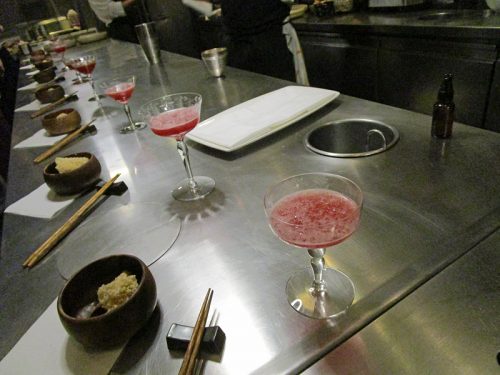
I, on the other hand, probably did wait too long to go—too many visits to Next, anyway, before I ever did. The sense of magic I hoped for throughout came in fits and starts—diminished by things like the clam chowder, revived by the visit to the kitchen and a certain device that seemed the charming invention of a mad Victorian scientist. Dessert would have been more magical if two of the three courses weren’t already more than familiar from social media (one involves helium, the other is their take on pumpkin pie). Well, they delighted my wife, who doesn’t follow food social media like I do, anyway.
Best restaurant in Chicago—I don’t even know what that means. (If you stuck Grant Achatz and me in a room and forced us to choose one, it’d probably be Smoque.) Alinea is clearly the one aiming most at an international audience of Michelin watchers, and if that’s its audience and they don’t already know the punchlines, it is built to amaze and delight them. I would recommend it to them without hesitation.
But I see a path that culinary evolution in Chicago has taken, and if Alinea was a spur from Trotter and El Bulli, it seems like many of the chefs who started down that path with Achatz eventually walked it back a little. Curtis Duffy’s food at Avenues was at least as Alineaish as Alinea, dots and squiggles and powders, yet at Grace he returned to the primacy of ingredients, carefully balanced. John Shields at Smyth is even more Japanese, even more abstract, and yet his food is grounded and rooted in farm to table (Alinea has never dropped a farmer name on the menu in its life). Enough to say that Alinea changed the direction of high end food in Chicago—and then poured hot water on it, and filled the room with it.
Michael Gebert is the ¶ of Fooditor.
Latest
Join the Discussion
After you comment, click Post. If you're not already logged in you will be asked to log in or register with Disqus.





